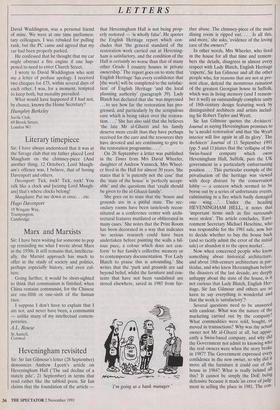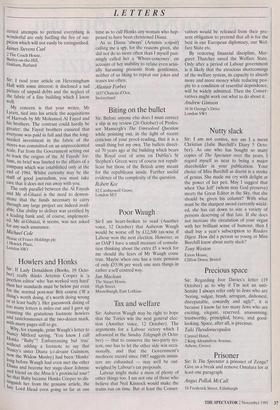Heveningham revisited
Sir: Sir Ian Gilmour's letter (28 September) denounces Andrew Lycett's article on Heveningham Hall (`The sad decline of a stately pile', 21 September) in terms that read rather like the tabloid press. Sir Ian claims that the foundation of the article — that Heveningham Hall is not being prop- erly restored — 'is wholly false'. He quotes the English Heritage report which con- cludes that 'the general standard of the restoration work carried out at Hevening- ham is satisfactory, and the condition of the Hall is certainly no worse than that of many other Grade I country houses in private ownership.' The report goes on to state that English Heritage 'has every confidence that [the work] will be completed to the satisfac- tion' of English Heritage 'and the local planning authority' (paragraph 39). Lady Blatch has declared that she 'was impressed ... to see how far the restoration has pro- gressed, and particularly by the scrupulous care which is being taken over the restora-
tion. .' She has also said that she believes 'the late Mr al-Ghazzi and his family deserve more credit than they have perhaps received for the care and the resources they have devoted and are continuing to give to the restoration programme....'
On 28 September a letter was published in the Times from Mrs David Wheeler, daughter of Andrew Vanneck. Mrs Wheel- er lived in the Hall for almost 30 years. She states that it 'is patently not the case' that the 'state of the house' is 'perfectly accept- able' and she questions that 'credit should be given to the al-Ghazzi family'.
She goes on to state that the 'house and grounds are in a pitiful state. The sec- ondary rooms have been tastelessly recon- stituted as a conference centre with archi- tectural features mutilated or obliterated in many cases.' She notes that the Print Room has been decorated in a way that indicates `no serious research could have been undertaken before painting the walls a bil- ious puce, a colour which does not con- form' to her family's collective memory or to contemporary documentation. 'For Lady Blatch to praise this is astounding.' She writes that the 'park and grounds are sad beyond belief, whilst the furniture and con- tents that have not been vandalised are stored elsewhere, saved in 1985 from fur- I'm going as a bank manager.' ther abuse. The chimney-piece of the main dining room is ripped out. . . Is all this, and more,' she asks, 'evidence of the loving care of the owners?'
In other words, Mrs Wheeler, who lived in the house for all that time and remem- bers the details, disagrees in almost every respect with Lady Blatch, English Heritage 'experts', Sir Ian Gilmour and all the other people who, for reasons that are not at pre- sent clear, defend the monstrous ruination of the greatest Georgian house in Suffolk, which was in living memory (and I remem- ber it well) an outstandingly complete unity of 18th-century design featuring work by distinguished architects and artists includ- ing Sir Robert Taylor and Wyatt.
Sir Ian Gilmour quotes the Architects' Journal as saying Heveningham promises to be 'a model restoration' and that 'the Wyatt interior will live again in all its glory'. The Architects' Journal of 11 September 1991 (pp. 5 and 11)states that the 'collapse of the Swiss-based company which owns Heveningham Hall, Suffolk, puts the UK government in a particularly embarrassing position . . . This particular example of the privatisation of the heritage was viewed with deep distrust by the conservation lobby — a concern which seemed to be borne out by a series of unfortunate events, culminating in a fire which badly damaged one wing. . .'. Under the heading HEVENINGHAM HELL, it notes that 'important items such as fire surrounds were stolen'. The article concludes, 'Envi- ronment Secretary Michael Heseltine, who was responsible for the 1981 sale, now has to decide whether to buy the house back (and so tacitly admit the error of the initial sale) or abandon it to the open iiiajket.
Now when concerned people who know something about historical architecture, and about 18th-century architecture in par- ticular, and who knew Heveningham before the disasters of the last decade, are deeplY unhappy about the state of the house, is It not curious that Lady Blatch, English Her- itage, Sir Ian Gilmour and others are so keen to say everything is wonderful and that the work is 'satisfactory'?
Several questions need to be answered with candour. What was the nature of the marketing carried out by the company? What commodities were sold, bought, or moved in transactions? Why was the actual owner not Mr al-Ghazzi at all, but appar- ently a Swiss-based company, and why did the Government not admit to knowing who the real owners were when the story broke in 1987? The Government expressed everY confidence in the new owner, so why did it move all the furniture it could out of the house in 1984? What is really behind this? It cannot be simply the DoE being defensive because it made'an error of judg- ment in selling the place in 1981. The con-
LETTERS
eerted attempts to pretend everything is wonderful are only fuelling the fire of sus- picion which will not easily be extinguished. James Stevens Curl
2 The Coach House, Burley-on-the-Hill, Oakham, Rutland



































































 Previous page
Previous page